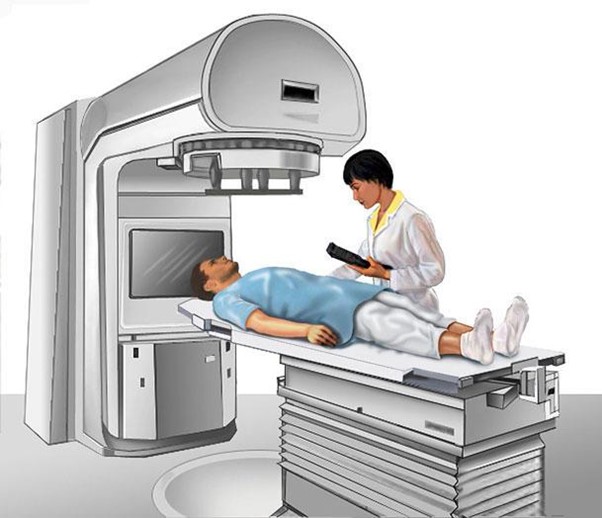A nurse is providing teaching to a client who is to begin external radiation therapy for cancer. Which of the following information should the nurse include?
"You might experience altered taste sensations."
"Use rubbing alcohol to remove the ink markings."
"Wear a binder over the radiation site."
"Wash your skin thoroughly with a washcloth after each treatment."
The Correct Answer is A
Choice A reason:
"You might experience altered taste sensations" is the correct statement. When providing teaching to a client about to undergo external radiation therapy for cancer, the nurse should include information about potential side effects and what to expect during the treatment. One common side effect of radiation therapy, especially when the treatment is focused on or near the head and neck region, is altered taste sensations. Radiation can affect the taste buds and lead to changes in how foods taste.
Choice B reason:
"Use rubbing alcohol to remove the ink markings. “The statement is incorrect. The ink markings made on the client's skin are used as reference points for the radiation therapy treatment. It is essential not to remove these markings, as they are crucial for accurate positioning during each treatment session. The nurse should instruct the client not to tamper with the markings, and the radiation therapy team will remove them when they are no longer needed.
Choice C reason:
"Wear a binder over the radiation site." The statement is incorrect. Wearing a binder over the radiation site is not a standard practice during external radiation therapy. The client should be instructed to follow the specific guidelines provided by the radiation therapy team regarding clothing and positioning during treatments. The use of binders or other tight clothing over the treatment area may not be recommended, as it can cause discomfort or interfere with the delivery of radiation.
Choice D reason
"Wash your skin thoroughly with a washcloth after each treatment." Is incorrect statement. During radiation therapy, the skin in the treatment area can become sensitive. It is essential for the client to follow the specific instructions provided by the radiation therapy team regarding skin care. Generally, the client should avoid using harsh soaps or scrubbing the skin vigorously. Instead, they should gently cleanse the area with a mild soap or as directed by their healthcare providers.

Nursing Test Bank
Naxlex Comprehensive Predictor Exams
Related Questions
Correct Answer is B
Explanation
The correct answer is choice b. "I can start the medication 30 minutes earlier."Choice A rationale: This is an inappropriate response, as the nurse should not adjust the time and schedule for the administration of alteplase recombinant, which is a time-sensitive medication used to treat a thrombus in the coronary artery. The administration of this medication must be done within a specific time frame to be effective.Choice B rationale: This is the correct answer. Alteplase recombinant is a thrombolytic medication used to dissolve blood clots in the coronary artery. It is a time-sensitive medication, and it is crucial to administer it as soon as possible to minimize the damage to the heart muscle. Starting the medication 30 minutes earlier is an appropriate action to include in the plan of care, as it can help ensure the medication is administered within the recommended time frame.Choice C rationale: This is an inappropriate response. Alteplase recombinant should be administered within a specific time frame, typically within 3 to 4.5 hours of the onset of symptoms. Waiting up to 2 hours after the usual schedule time to give the medication would be outside the recommended time frame and could potentially reduce the effectiveness of the treatment.Choice D rationale: This is an inappropriate response. Alteplase recombinant should be infused at a specific rate, as recommended by the manufacturer or healthcare provider. Infusing the medication at a faster rate could increase the risk of adverse effects and should not be included in the plan of care without specific instructions from the healthcare provider.
Correct Answer is A
Explanation
The correct answer is choice A. The nurse should ensure the state health department has been notified of the child’s Lyme disease, as it is a reportable disease in most states.
Reporting helps to monitor the incidence and prevalence of Lyme disease and to implement prevention and control measures.
Choice B is wrong because antitoxin is not used to treat Lyme disease.
Antitoxin is a substance that neutralizes the effects of a toxin, such as botulism or tetanus. Lyme disease is caused by a bacterium called Borrelia burgdorferi, which can be treated with antibiotics.
Choice C is wrong because Lyme disease is not transmitted by sharing personal belongings. Lyme disease is spread to humans by the bite of infected ticks that carry the
bacterium. The risk of getting Lyme disease can be reduced by avoiding tick-infested areas, wearing protective clothing, using insect repellent, and removing ticks promptly.
Choice D is wrong because skin necrosis is not a common complication of Lyme disease.
Skin necrosis is the death of skin tissue due to lack of blood supply or infection. Lyme disease can cause a characteristic skin rash called erythema migrans, which is usually circular or oval and expands over time. Other possible signs and symptoms of Lyme disease include fever, headache, fatigue, joint pain, and neurological problems.
Whether you are a student looking to ace your exams or a practicing nurse seeking to enhance your expertise , our nursing education contents will empower you with the confidence and competence to make a difference in the lives of patients and become a respected leader in the healthcare field.
Visit Naxlex, invest in your future and unlock endless possibilities with our unparalleled nursing education contents today
Report Wrong Answer on the Current Question
Do you disagree with the answer? If yes, what is your expected answer? Explain.
Kindly be descriptive with the issue you are facing.
